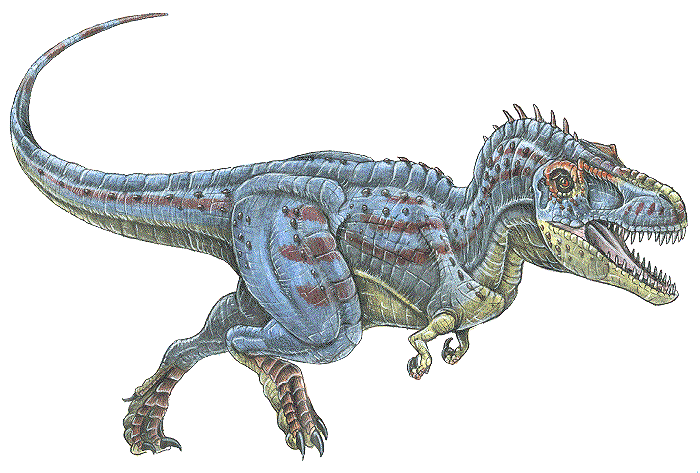|
|
|
Daspletosaurus torosus (Dale Alan Russell,1970) |
 |
|
Name Means: |
"Frightful Lizard" |
Length: |
30 feet (9 m) |
|
Pronounced: |
dass-Plee-toe-Saw-rus |
Weight: |
3 tons (2,700 kilos) |
|
When it lived: |
Late Cretaceous - 76 MYA |
|
|
|
Where found: |
Alberta, Canada; Montana, US |
|
|
|
|
Introduction |
Daspletosaurus torosus was an enormous animal,
almost 30 feet long, weighing 3 tons. It was an early member of the
tyrannosaur family and looks like a smaller version of T. rex.
There is evidence that Tyrannosaurus may have been directly
descended from Daspletosaurus.
Stocky and powerful, this meat-eater lived in marshes by streams.
It had tiny horns behind its eyes and the largest teeth of any of the
tyrannosaurids. Each tooth was dagger-sharp, curved, and saw-edged.
With its formidable teeth and jaws, clawed feet, and sheer bulk,
Daspletosaurus torosus was easily capable of killing even the
largest of its herbivorous prey. Like other tyrannosaurids, this
species also had a pair of small, two-fingered hands.
Tyrannosaurids, the "tyrant lizards", are the best-known family of
dinosaurs and are the largest terrestrial carnivores that ever lived.
They appeared in Late Cretaceous times around 80 million years ago.
Most of them vanished during the mysterious mass extinction of all
dinosaurs, 65 million years ago. For some unknown reason,
Daspletosaurus torosus came to an end about three million years
before the great dinosaur extinction. |
|
History |
Daspletosaurus was discovered in 1921 by Charles Sternberg on the
banks of a river in Alberta, Canada. These partial remains were
thought by Sternberg to be a dinosaur he called
Gorgosaurus. At first, some scientists argued that
Daspletosaurus was a larger more adult version of Albertosaurus.
Subsequent study, however, has proved otherwise. It was a typical
tyrannosaur, with shorter, two-fingered front limbs. It was more
robust than Albertosaurus, its contemporary cousin, and it is
speculated that it was better suited to hunting the slower horned
dinosaurs, thus leaving the faster hadrosaurs to the lighter and
speedier Albertosaurus.
Later discoveries, however, added more pieces to the puzzle,
and almost 50 years after the first discovery, Dr. Dale Russell was
able to determine that this dinosaur was both a new species and genus,
which he called Daspletosaurus. predators hunted their
last, C.M. Sternberg discovered the fossilized bones of one of these
"frightful, fleshy lizards" on the . More recently a specimen was
found (MOR 590) that was a cross between T. rex and D.
torosus, with no characteristics unique to itself. There are also
specimens in New Mexico that are a possible new species. There is also
a distinction between specimens from the Old Man Formation and the
Dinosaur Provincial Park Formation specimens, so that makes two,
three, or even four species of Daspletosaurus. This
dinosaur provides a good example of the research methods used
by scientists over many years whereby they build on each other's
discoveries to form a conclusion about a related group.
There are now about six good known specimens of Daspletosaurus
and parts of several others have been found). The Royal Tyrell
Museum has one mounted at their Field Museum in Dinosaur Provincial
Park. The Canadian Museum of Nature recently unveiled a full-size
model of one. |
|
|
|
|
|
|
|
|
Edugraphics.Net | Feenixx Publishing |
|
|
|
|
